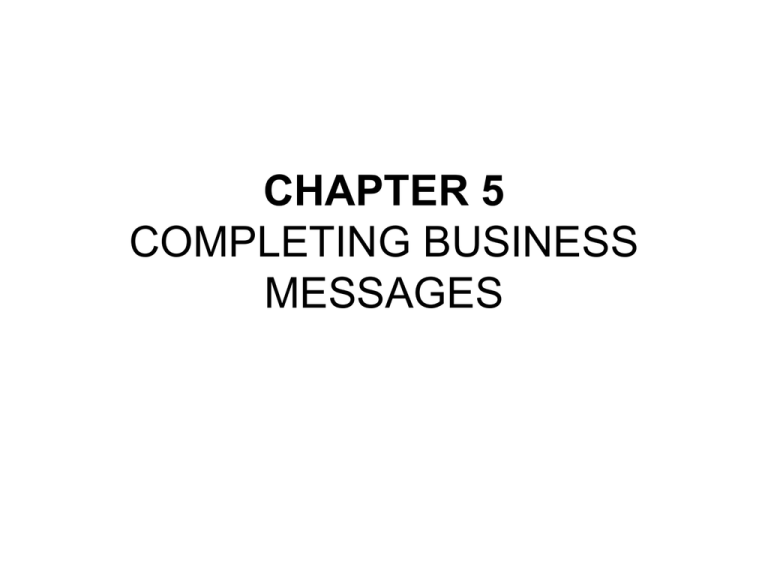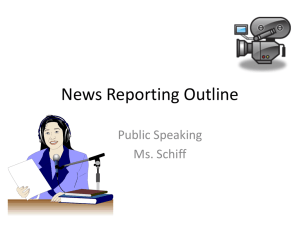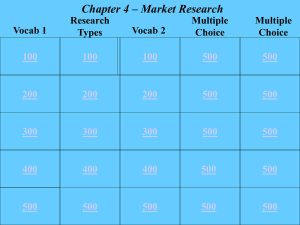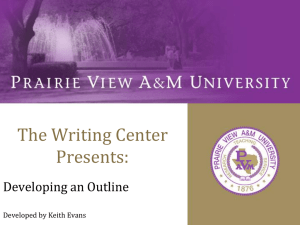chapter 5 completing business messages
advertisement

CHAPTER 5 COMPLETING BUSINESS MESSAGES • True/False • ______ If possible, it is better to revise a few days after completing a first draft rather than right away. • ______The beginning and end of a message are the parts that have the most impact on an audience. • ______ Hedging statements are used when the writer wants to avoid stating a judgment as fact. • True/False • ______ If possible, it is better to revise a few days after completing a first draft rather than right away. • ANSWER: True. This lets you approach the material with a fresh eye. • DIFFICULTY: easy; PAGE: 92; OBJECTIVE: 1; TYPE: concept; AACSB: Communication • ______The beginning and end of a message are the parts that have the most impact on an audience. • ANSWER: True. These sections are read first and make the most impact on the audience. • DIFFICULTY: moderate; PAGE: 92; OBJECTIVE: 1; TYPE: concept; AACSB: Communication • ______ Hedging statements are used when the writer wants to avoid stating a judgment as fact. • ANSWER: True. Hedging statements are used when the writer wants to avoid stating a judgment as fact. • DIFFICULTY: moderate; PAGE: 95; OBJECTIVE: 3; TYPE: concept; AACSB: Communication • Fill-in the blank • The ______ of a document should summarize the main idea and leave the audience with a positive impression. • Unlike informative headings, ______ headings identify a topic but do little more. • To eliminate ______ sentences, you should avoid words such as “may” or “seems.” • Fill-in the blank • The ______ of a document should summarize the main idea and leave the audience with a positive impression. • ANSWER: Conclusion • DIFFICULTY: moderate; PAGE: 93; OBJECTIVE: 1; TYPE: concept; AACSB: Communication • Unlike informative headings, ______ headings identify a topic but do little more. • ANSWER: Descriptive • DIFFICULTY: difficult; PAGE: 94; OBJECTIVE: 2; TYPE: concept; AACSB: Communication • To eliminate ______ sentences, you should avoid words such as “may” or “seems.” • ANSWER: Hedging • DIFFICULTY: moderate; PAGE: 95; OBJECTIVE: 3; TYPE: concept; AACSB: Communication Multiple Choice 1. All of the following are points to consider in making the design elements effective, except a. b. c. d. 2. strive for a number of decorative touches. be consistent throughout the message regarding margins, type size, and typeface. balance all of the visual elements. pay attention to design details such as headings, column width, etc. All of the following are ways of making your document design more effective except a. b. c. d. being consistent. maintaining balance. using spell check. being detail oriented. 1. All of the following are points to consider in making the design elements effective, except a. b. c. d. • ANSWER: a. Pointers include: be consistent; balance text, white space and visuals; strive for simplicity; and attention to details. DIFFICULTY: difficult; PAGE: 104; OBJECTIVE: 5; TYPE: concept; AACSB: Communication All of the following are ways of making your document design more effective except • 1. a. b. c. d. • • strive for a number of decorative touches. be consistent throughout the message regarding margins, type size, and typeface. balance all of the visual elements. pay attention to design details such as headings, column width, etc. being consistent. maintaining balance. using spell check. being detail oriented. ANSWER: c. Although it is important to check for spelling errors, using spell check is not a method of improving the design of your documents. DIFFICULTY: moderate; PAGE: 104; OBJECTIVE: 5; TYPE: concept; AACSB: Communication APPENDIX A FORMAT AND LAYOUT OF BUSINESS DOCUMENTS Multiple Choice 1. The quality of paper is measured by a. length and width. b. weight and cotton content. c. color and texture. d. whether or not it is imprinted with the name and address of the company. 2. The proper sequence for the standard parts of a letter is a. heading, date, inside address, salutation, body, complimentary close, signature block. b. date, heading, inside address, salutation, body, typewritten name, complimentary close. c. salutation, date, heading, inside address, body, complimentary close, signature block. d. inside address, heading, date, salutation, body, complimentary close, typewritten name. • • a. b. c. d. • • • a. b. c. d. • • • APPENDIX A • FORMAT AND LAYOUT OF BUSINESS DOCUMENTS Multiple Choice 1. The quality of paper is measured by length and width. weight and cotton content. color and texture. whether or not it is imprinted with the name and address of the company. ANSWER: b. These are two criteria. DIFFICULTY: moderate; PAGE: A-1; TYPE: concept 2. The proper sequence for the standard parts of a letter is heading, date, inside address, salutation, body, complimentary close, signature block. date, heading, inside address, salutation, body, typewritten name, complimentary close. salutation, date, heading, inside address, body, complimentary close, signature block. inside address, heading, date, salutation, body, complimentary close, typewritten name. ANSWER: a. This is the correct order. DIFFICULTY: moderate; PAGES: A-2–A-6; TYPE: concept • True/False 1. Letterhead stationery never includes the URL of the company’s website. 2. In business documents, abbreviations such as U.S.A. and M.B.A. must always contain periods. 3. “Sept. 10th, 2009” is the correct way to type the date in a letter. • True/False • 11. Letterhead stationery never includes the URL of the company’s website. • ANSWER: False. This is commonly included. • DIFFICULTY: easy; PAGE: A-2; TYPE: concept • 12. In business documents, abbreviations such as U.S.A. and M.B.A. must always contain periods. • ANSWER: False. These abbreviations may or may not include periods, but should never have internal spaces. • DIFFICULTY: moderate; PAGE: A-2; TYPE: concept • 13. “Sept. 10th, 2009” is the correct way to type the date in a letter. • ANSWER: False. There are several acceptable formats, but none would include th following the date. • DIFFICULTY: moderate; PAGE: A-2; TYPE: application APPENDIX B DOCUMENTATION OF REPORT SOURCES Multiple Choice 1. With MLA style, you use a. the author-date system. b. the author-page number system. c. superscripts and footnotes or endnotes. d. full citations within the text itself. 2. In the list of works cited following the MLA style a) the date comes immediately after the author’s name. b) electronic sources are not included. c) the titles of books and periodicals are put in quotation marks. d) all the main words are capitalized in the titles of books and articles. • • a. b. c. d. • • • a. b. c. d. • • Multiple Choice 9. With MLA style, you use the author-date system. the author-page number system. superscripts and footnotes or endnotes. full citations within the text itself. ANSWER: b. MLA citations include the author’s last name and a page reference following the cited material. DIFFICULTY: moderate; PAGE: A-24; TYPE: concept 10. In the list of works cited following the MLA style the date comes immediately after the author’s name. electronic sources are not included. the titles of books and periodicals are put in quotation marks. all the main words are capitalized in the titles of books and articles. ANSWER: d. This is one characteristic that distinguishes MLA style from APA style. DIFFICULTY: moderate; PAGE: A-25; TYPE: concept • True/False 1. Always use APA style for documentation in business reports, even if your employer or client normally uses a different form. 2. The Chicago Humanities style refers to the documentation style used by companies in the Chicago area. 3. Footnotes and endnotes are identical; the only difference between the two is their placement. • True/False • Always use APA style for documentation in business reports, even if your employer or client normally uses a different form. • ANSWER: False. If your employer or client specifies a form, use it. • DIFFICULTY: moderate; PAGE: A-20; TYPE: concept The Chicago Humanities style refers to the documentation style used by companies in the Chicago area. • ANSWER: False. It refers to a style of documentation recommended in the Chicago Manual of Style. • DIFFICULTY: moderate; PAGE: A-20; TYPE: concept Footnotes and endnotes are identical; the only difference between the two is their placement. • ANSWER: True. This is the only difference. • DIFFICULTY: moderate; PAGE: A-20; TYPE: concept







